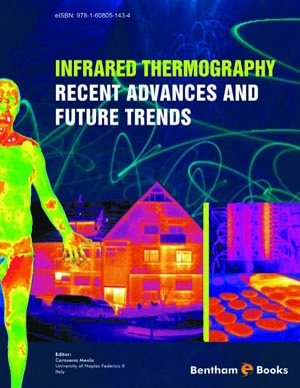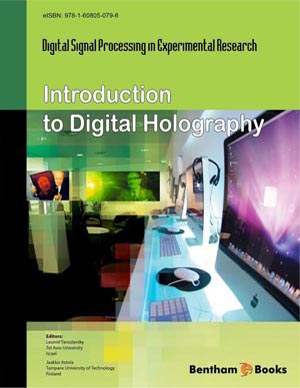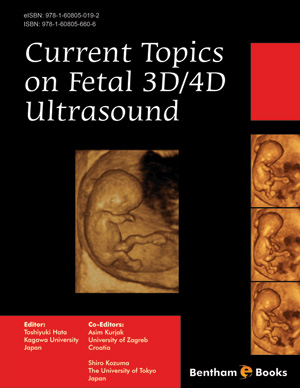Origin and Theory of Infrared Thermography
Page: 3-28 (26)
Author: Carosena Meola
DOI: 10.2174/978160805143411201010003
PDF Price: $15
Abstract
The intention of this chapter is to trace the origin of infrared thermography (IRT) and to supply its theoretical basis. The speech goes through the milestones by eminent scientists and is supported by the most important basic relationships. The reader is also plunged into radiation mechanisms which are fundamental as starting points for comprehension and then application of infrared thermography. A section is devoted to detector’ technology with a description of the basic features, which should be taken into account for the choice of the most appropriate equipment for the specific application. The main historical steps in detector’ development are also traced owing to the dynamic evolution of the infrared devices. Indeed, following the technological progress, the performance of infrared devices improves ever more, leading to novel applications.
Infrared Devices: Short History and New Trends
Page: 29-59 (31)
Author: Roberto Rinaldi
DOI: 10.2174/978160805143411201010029
PDF Price: $15
Abstract
This chapter deals with the historical evolution of infrared technology from the first prototype developed in 1958 to the multitude of models, which are available today. Particular attention is devoted to the detectors’ working principles, their characteristics and performance as well their main fields of application. A section is devoted to radiometric systems involving: image generation and uniformity correction.
Concluding Remarks to Part I
Page: 60-60 (1)
Author: Carosena Meola
DOI: 10.2174/978160805143411201010060
PDF Price: $15
Abstract
The aim of Part I was to introduce infrared thermography from the historical/theoretical perspective. Infrared thermography is becoming ever more popular embracing ever more numerous fields of applications. Now, there is availability of a vast multitude of infrared imaging devices to cover almost every type of applications. In the same time, infrared thermography is still not appropriately exploited mainly because of insufficient scientific and technical information.....
Applications of Infrared Thermography to Medicine
Page: 61-84 (24)
Author: Boris G. Vainer
DOI: 10.2174/978160805143411201010061
PDF Price: $15
Abstract
Medicine is one of the most active fields in the use of infrared thermography (IRT). Medical diagnostics and monitoring today afford an opportunity to utilize the unique potentials of modern computer equipped FPA-based infrared cameras. At the same time, a large majority of IRT-assisted diagnostic methods and medical investigations are still modelled on the principles developed on the basis of instruments of previous generations. The aim of this chapter is to present the range of problems on up-to-date medical IRT in an orderly fashion and to unveil the unique capabilities of this method as applied to medicine.
The Use of Infrared Thermography in Livestock Production and Veterinary Field
Page: 85-101 (17)
Author: Petr Kunc and Ivana Knizkova
DOI: 10.2174/978160805143411201010085
PDF Price: $15
Abstract
This chapter presents the application and use of infrared thermography (IRT) in farm animals and veterinary medicine. Changes in vascular circulation in living organisms result in an increase or decrease in tissue temperature, which is then used to evaluate the situation in the given area. IRT is mainly used in veterinary medicine, primarily for diagnostic purposes, particularly in the diagnosis of orthopaedic diseases in horses. IRT can, however, be used extremely successfully for study and research in farm animals such as pigs, cattle, sheep and poultry. Areas of research include reproduction, thermoregulation, animal welfare and the milking process. Although IRT is applied less frequently in the study of the milking process, recent results show the potential of this measuring method. Generally, IRT is a suitable tool for early detection and screening for mastitis, and can also be useful for studying and evaluating the effects of various milking techniques on the teats and udders. IRT is recommended as a method that can produce important information where the possibilities of conventional diagnostic techniques have been exhausted. There are, however, certain limitations and factors that must be considered when using IRT in animals.
Concluding Remarks to Part II - Section 1
Page: 102-102 (1)
Author: Carosena Meola
DOI: 10.2174/978160805143411201010102
PDF Price: $15
Abstract
This Section I of Part II was concerned with application of infrared thermography in the medical field; the first chapter was devoted to human medicine and the second one to veterinary.
Chapter 3 reports on the IRT’s state of art in medicine with methodological approaches and a variety of applications such as in the diagnosis of breast cancer, in ophthalmologic surgery, in cardiovascular surgery, in the visualization of ischemic tissues and in many others. As illustrated in this chapter, infrared thermography roused soon interest, since the middle fifties, in the medical community owing to the Hippocrates’ criterion to diagnose diseases in humans from temperature features. But, there was also wide skepticism and loose of interest mainly due to lack of well assessed procedures and difficulties in the data interpretation also because of the poor sensitivity of old devices. Renewed interest is today justified by the availability of computerized FPA high performance cameras. However, the infrared thermography is still not adequately exploited in medicine because there are still difficulties in the interpretation of thermograms.
What is the situation in veterinary?.....
Application of Infrared Thermography in Fruit and Potato Storage
Page: 103-132 (30)
Author: Klaus Gottschalk
DOI: 10.2174/978160805143411201010103
PDF Price: $15
Abstract
An infrared camera is used to investigate the conservation condition of fruits and vegetables. Crops like apples or carrots are exposed to mechanical impacts that are caused by post harvest treatments like washing or grading. The resulting intensification of respiration causes a temperature decrease on the moist surface which is under evaporation; this is detectable with infrared thermography (IRT). In fact, IRT can be exploited to monitor current temperature distributions, to measure low local temperature differences and to visualize the influences of airflow within a wide area of a store. An appropriated climate control is crucial to maintain the quality and to enhance the shelf life of stored agricultural products like fruit, vegetable and potatoes. Hence, an infrared camera can help improve the climate control performance. The camera can be embedded in a wired system for data exchange and remote control. A number of well placed cameras distributed in the store enhance the visibility, and hence the controllability of the store. The investment cost can be paid back within several years if the IR camera system can help to improve the climate control for reducing mass loss (shrinkage) and prolonging shelf life of the crop.
Concluding Remarks to Part II - Section 2
Page: 133-133 (1)
Author: Carosena Meola
DOI: 10.2174/978160805143411201010133
PDF Price: $15
Abstract
The use of an infrared imaging device for monitoring the environmental conditions for foodstuff conservation was illustrated in Section 2 of Part II. From the reported data, it is evident the convenience of using infrared thermography to control the climate of the store house and the respiratory activity of harvests. The author also supplied information on the location of infrared cameras in the store house and on the procedures for data treatment and interpretation.
Of course, the climate conditions are fundamental for the correct conservation of foodstuff for preventing loss of mass and of freshness with obvious economical profits. However, the conservation of foodstuff is a crucial task not only from the economic point of view, but primarily from the wellbeing perspective. In fact, the temperature and the humidity level are key parameter to be accurately set for avoiding bacterial proliferation. Not with standing the benefits, the investment costs are often considered prohibitive for stores
not enough large. Fortunately, as pointed out in Chapter 2 (Part I), the technology is evolving fast while costs are becoming more affordable, and then, it is expected an increasing use by also small stores. Now, the eBook goes on an excursion into applications of infrared thermography to the industrial field for comprehension of thermo-fluid-dynamics phenomena and for materials non destructive inspection. The use of an infrared device for climate control will be reconsidered in Section 4 but for the living comfort and to prevent degradation of artworks.
An Overview on IR Thermography for Thermo-Fluid-Dynamics
Page: 134-164 (31)
Author: Giovanni M. Carlomagno
DOI: 10.2174/978160805143411201010134
PDF Price: $15
Abstract
This chapter deals with the exploitation of thermographic measurements in complex fluid flow configurations for the evaluation of the maps of wall convective heat fluxes. The measurement of convective heat fluxes is always performed with a heat flux sensor described by a suitable heat transfer model, where proper temperatures must be measured. By correctly choosing the measuring sensor, infrared (IR) thermography can be exploited to resolve convective heat flux maps in complex fluid flows with both steady and transient techniques. Compared to standard transducers, an IR camera appears very valuable because it is non-intrusive, has a high sensitivity (down to 20mK), has a low response time (down to 20μs), and is fully two-dimensional (from 80k up to 1M pixels) allowing for accurate detection of heat flux variations and better evaluation of errors due to radiation and tangential conduction within the sensor. After mentioning the first historical steps, this chapter reviews the most useful heat flux sensors, thermal restoration of data and several examples of convective heat transfer measurements in complex fluid flows, ranging from natural convection to hypersonic regime, which were performed by the author and his co-workers.
Infrared Imaging to Combustion Systems
Page: 165-180 (16)
Author: Christophe Allouis and Rocco Pagliara
DOI: 10.2174/978160805143411201010165
PDF Price: $15
Abstract
This chapter covers a wide range of applications of infrared imaging systems to combustion, from both specific and practical scientific points of view. Recent new applications are also presented in the last part. The availability of new sophisticated and flexible IR sensors makes possible the applicability of IR devices, as complementary tools, to existing techniques for combustion characterization. In fact, an IR camera allows visualization of phenomena that cannot be caught by the UV-Visible cameras. Different aspects of InfraRed imaging systems utilization are presented here from the choice of the sensor to the specific application. Particular attention is focused on the use of Fast IR Imaging of flames applied in two different types of gas turbine burners and in two traditional industrial burners. We illustrate how useful is the IR imaging device for temporally and spatially characterizing the combustion fluctuations. Finally, we discuss the undergoing developments of the application of IR-based sensors for burner control.
Pulse and Lock-In NDT Infrared Active-Source Techniques
Page: 181-198 (18)
Author: Ralph A. Rotolante
DOI: 10.2174/978160805143411201010181
PDF Price: $15
Abstract
Infrared Pulse and Lock-In techniques are in use for NDT applications worldwide for Defect Imaging, Stress Imaging, Solar-Cell Shunt Imaging, Solar-Cell Carrier-Density/Lifetime Imaging, and Semiconductor Photo-and Electro-Luminescence imaging. A variety of active-sources, various infrared camera types and a selection of analytical tools are available for monitoring the responses of the materials to the active-sources. This chapter presents an overview of this rich choice of NDT tools used in academia, laboratories and factories for studies of material types ranging from composites, metals, ceramics, polymers and concrete, to semiconductors, solar cells, bones, leather and cheese, and projects strong future growth for the technology.
Concluding Remarks to Part II - Section 3
Page: 199-199 (1)
Author: Carosena Meola
DOI: 10.2174/978160805143411201010199
PDF Price: $15
Abstract
Section 3 of Part II was devoted to the employment of infrared thermography in industrial engineering. Two main topics were addressed, which are concerned with thermo-fluid-dynamics phenomena (chapters six and seven) and nondestructive evaluation of materials (chapter eight).
An overview on the applications in thermo-fluid-dynamics starting from the first attempts performed in the middle 60s with the AGA Thermovision 680 to the most recent measurements of convective heat transfer with the SC3000 (the camera models were described in Part I) was given in Chapter 6. A description of the heat flux sensors, mostly used with infrared thermography, was provided in section 2 of this chapter; the problem of image restoration was also addressed. In this chapter were also illustrated some examples of applications to fluid dynamics, ranging from natural convection to hypersonic regime, and involving transition, separation and reattachment phenomena, jets, flow instability, rotating devices, etc. which bear witness for the capability of infrared thermography to deal with complex fluid flows.
A particular application to the visualization of combustion phenomena was described in Chapter 7. A fast InfraRed PHOENIX Camera equipped with a detector working in the 1.5-μm wavelength, and of frame rate up to 38kHz was used, which is a particular sophisticated camera model for specific applications. It is worth noting that suppliers of infrared cameras are generally open to customer requirements. The authors of Chapter 7 focused on the usefulness of infrared thermography for characterization of temporal and spatial combustion fluctuations. They also highlighted the high sensitivity of the infrared camera, which allowed for individuation of high and low temperature/emissivity scatterers, namely hot gases (CO2) and small particles (coal, particulate).
Infrared thermography is also a powerful technique for non destructive testing of materials; this topic was addressed in Chapter 8. After a short historical overview, a description of the main techniques, pulse and lock-in, with a panorama of stimulation sources and types of detected defects was given; the most important relationships were also described. The description was accompanied by examples of applications in the aerospace field. Indeed, infrared thermography is particularly useful in the inspection of advanced composites which are ever widely employed in the fabrication of aerospace structures. As remarked in the conclusions to this chapter, as the technological progress in both excitation sources and infrared cameras go forward, the inspection of ever novel materials and structures becomes possible.
Infrared thermography, as non destructive evaluation technique, is mostly useful also in the architecture and civil engineering field. This topic is covered in the following last section 4.
State of the Art and Perspective of Infrared Thermography Applied to Building Science
Page: 200-229 (30)
Author: Ermanno Grinzato
DOI: 10.2174/978160805143411201010200
PDF Price: $15
Abstract
IR thermography is more and more extensively used; amongst its applications, civil engineering is one of primary importance. In fact, performance indicators for new and existing buildings are derived from the temperature pattern. This is true, for both the envelope and plant investigations. The preventive maintenance and energy savings are addressed with qualitative or quantitative techniques. Non-destructive testing and evaluation of the repair and decay status is a hot issue. In this chapter, some examples of structural analysis aided by IR thermography, are presented and discussed. In particular, it is evidenced that help to the comfort monitoring given by the distributed temperature map measured by an infrared device is impressive. Using a novel method, it is possible to “see” the main environmental quantities such as air temperature, relative humidity and velocity, obtained from thermographic readings. Also, the well established application of thermography in building science for the detection of moisture is addressed. The discussion includes both the classical and innovative techniques, which are now available for dealing with usual or more complex problems. As the characterization of building materials by thermal properties is impressively improved by thermographic techniques, it is also demonstrated. The dedicated procedures, which have been developed since a long time ago for heritage building, are also reported and discussed herein.
Concluding Remarks to Part II - Section 4 and Final Closure
Page: 231-231 (1)
Author: Carosena Meola
DOI: 10.2174/978160805143411201010231
PDF Price: $15
Introduction
Infrared thermography (IRT) is a non-contact, non-invasive methodology which allows for detection of thermal energy that is radiated from objects in the infrared band of the electromagnetic spectrum, for conversion of such energy into a visible image (such as a surface temperature map). This feature represents a great potential to be exploited in a vast variety of fields from aerospace to civil engineering, to medicine, to agriculture, etc. However, IRT is still not adequately enclosed in industrial instrumentation and there are still potential users who might benefit from the use of such a technique and who are not aware of their existence. This e-book conveys information about basic IRT theory, infrared detectors, signal digitalization and applications of infrared thermography in many fields such as medicine, foodstuff conservation, fluid-dynamics, architecture, anthropology, condition monitoring, non destructive testing and evaluation of materials and structures. The volume promotes an exchange of information between the academic world and industry, and shares methodologies which were independently developed and applied in specific disciplines.












